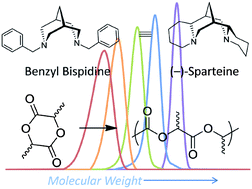Benzyl bispidine as an efficient replacement for (−)-sparteine in ring opening polymerisation†
Abstract
The synthesis and application of a dibenzyl-functionalized bispidine, in combination with

Maintenance work is planned for Wednesday 1st May 2024 from 9:00am to 11:00am (BST).
During this time, the performance of our website may be affected - searches may run slowly and some pages may be temporarily unavailable. If this happens, please try refreshing your web browser or try waiting two to three minutes before trying again.
We apologise for any inconvenience this might cause and thank you for your patience.
* Corresponding authors
a
Department of Chemistry, University of Warwick, Coventry, UK
E-mail:
a.p.dove@warwick.ac.uk
Tel: +44 (0)24 7652 4107
b University of Barcelona, Martí i Franquès Street, Barcelona, Spain
The synthesis and application of a dibenzyl-functionalized bispidine, in combination with

 Please wait while we load your content...
Something went wrong. Try again?
Please wait while we load your content...
Something went wrong. Try again?
R. Todd, G. Rubio, D. J. Hall, S. Tempelaar and A. P. Dove, Chem. Sci., 2013, 4, 1092 DOI: 10.1039/C2SC22053A
This article is licensed under a Creative Commons Attribution 3.0 Unported Licence. You can use material from this article in other publications without requesting further permissions from the RSC, provided that the correct acknowledgement is given.
Read more about how to correctly acknowledge RSC content.
 Fetching data from CrossRef.
Fetching data from CrossRef.
This may take some time to load.
Loading related content
